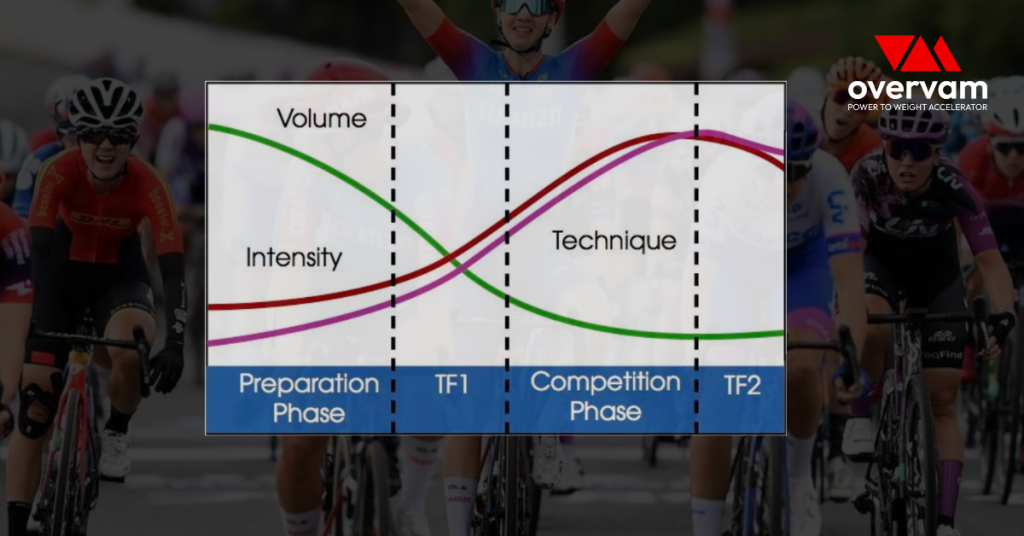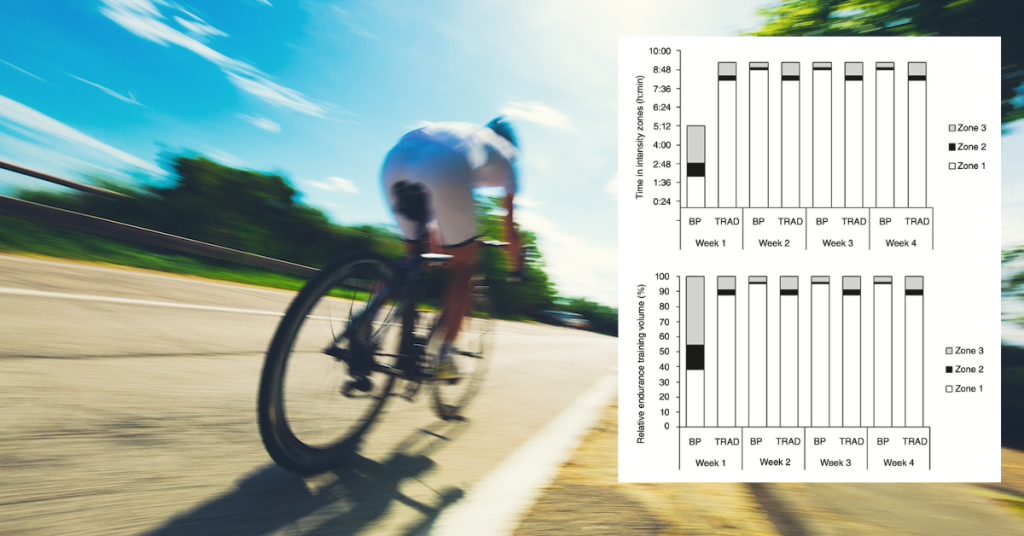TRAINING PERIODIZATION
Periodized training is the manipulation of intensity, duration, and frequency of training sessions over time to achieve the desired physiological adaptation for athletes to perform best during competitions. (Filipas et al., 2021).
In this article, you’ll read about how the science of periodized training evolved during the last 70 years. You will also learn which are the latest findings about cycling training periodization and which can be the optimal approach to periodization to reach your full potential for a specific event.
WHEN WAS PERIODIZATION FIRST ADOPTED?
The periodized training model derives from the definition of Matveyev, a Russian sports scientist of the 60s. His model of periodization proposes that training should gradually progress from low intensities and a large volume of work to high intensities and a low volume of work (1)

In 1999, the Russian scientist Prof. Verchoshanskij stated that: “It is the end of the “periodization of top-class sports training” (Juri V. Verchoshanskij: IAAF 14:1; 47-55, 1999). In his view, Matveev’s work on periodization needed to be scientifically proven and could not have a sufficient academic profile.
BLOCK TRAINING SYSTEM APPEARS MORE EFFECTIVE THEN THE PERIODIZATION TRAINING MODEL
Periodized training evolved significantly In 2007 when the Russian Scientist Prof. Yuri Verkhoshansky published a paper about the Block Training System Model (2).
This model had already funded an application in preparing athletes for the 1980 Moscow Olympic Games.
The innovative idea directed the training load volume of one training stage primarily towards only one training objective. This created a “persistent” training stimulus that influenced the most important factor of increasing sports performance.
WHAT CONTAINED THE BLOCK TRAINING SYSTEM?
In contrast with classic periodized training, The Block training System bases its fundamentals on three core principles:
- The Principle of Concentration. Applying this principle in different blocks ensures the possibility of yielding the most profound training influence on each organism’s other physiological systems.
- The Principle of Superimposition of concentrated training loads consists of the consecutive superimposition of training effects yielded by more specific and more intensive loads on the training effects (the adaptation traces) of previous loads.
- The Principle of Priority of the Special Strength Preparation implies a temporal placement of resistance exercises in the first stage of the Block Training System plan.
RECENT BIOLOGY ADVANCES CONFIRM THE SUPERIOR EFFECT ON THE PERFORMANCE OF BLOCK PERIODIZATION SYSTEMS THAN TRADITIONAL PERIODIZATION
Periodized training for cyclists reached a new era thanks to recent evidence (Rønnestad et al., 2012), confirming some of Prof Verkhoshansky’s findings!
Block periodization in cycling training induces a higher degree of adaptations when compared to a more traditional periodization, using protocols that provide similar training volumes and intensities.
The results suggest that Block Periodization induces more profound ergogenic adaptations in parameters important for endurance than traditional periodization.

With block periodization, cyclists increased their VO2max, Wmax, MAP (Maximal Aerobic Power), and power output at 2 mmol/L [la- ]; no changes occurred in the group that adopted traditional periodization. These findings agree with previous studies on the topic (Breil et al., 2010; GarcíaPallarés et al., 2010; Støren et al., 2011).
Amateur cyclists must know that adopting a block system training model may result in fatigue!
RECENT PERIODIZED TRAINING MODELS: A NEW FRONTIER?
Periodized Training: Training intensity distribution (TID) defines an athlete’s time in different training zones. (Filipas et al., 2021). Different combinations of TID define the most common periodized training.
The intensity distribution known as POLARIZED TRAINING includes the highest time spent in Z1, a smaller but relatively high percentage in Z3, and only a small portion of training in Z2 (i.e., Z1 > Z3 > Z2).
PYRAMIDAL TRAINING instead includes a higher volume of time spent in Z2 and less in Z3, but, as in the case of the polarized model, the absolute highest volume of time in Z1 (i.e., Z1 > Z2 > Z3) (Treff G. et al., 2019).
Although both training periodization models described in the literature offer great possibilities for improvement in endurance performance, recent evidence suggests that a specific combination of the two might deliver better results.
Notably, a periodization in which the POLARIZED model follows the PYRAMIDAL model demonstrates more significant benefits regarding increased performance. (Filipas et al., 2021)
WHICH IS THE BEST PERIODIZATION METHODOLOGY?
The answer about the best-periodized training model depends on many factors, including age, goals, time available for training, recovery, and the possibility of adequately managing nutrition.
A combination of Pyramidal followed by a Polarized Periodization may offer a more significant performance improvement. As suggested by Prof. Juri V. Verchoshanskij in his Principle of Priority of the Special Strength Preparation, Strength Training may find an optimal space in the early blocks of the season. Ultimately, block periodization may push a cyclist’s performance to his biological limit before core events, with careful attention to recovery for non-professional cyclists.

If you feel combining the different periodizations may be difficult, try the OVVERVAM app. This complete cycling training app creates optimal science-based periodization based on your personal goals. Available on the App Store, Google Play and OVERVAM Web.

Gherardo Marcolin, BSc, IOC Diploma in Sports Nutrition, Swiss Triathlon coach, Swiss Sports Nutrition Society, MBA, Cyclist and Triathlete.
REFERENCES
- Fundamentals of sports training. Matveyev L.; Fizkultura Sport Pubishers, 1977
- The Block Training System in Endurance Running; Yuri Verkhoshansky; 2007
- B. R. Rønnestad, J. Hansen, S. Ellefsen: Block periodization of high-intensity aerobic intervals provides superior training effects in trained cyclists. Scand J Med Sci Sports 2012: doi: 10.1111/j.1600-0838.2012.01485.
- Luca Filipas, Matteo Bonato, Gabriele Gallo, Roberto Codella. Effects of 16 weeks of pyramidal and polarized training intensity distributions in well-trained endurance runners. Wiley; 28 May 2021; DOI: 10.1111/sms.14101
- Gunnar Treff1, Kay Winkert1, Mahdi Sareban, Jürgen M. Steinacker and Billy Sperlich.The Polarization-Index: A Simple Calculation to Distinguish Polarized From Non-polarized Training Intensity Distributions.Front. Physiol., 12 June 2019; Volume 10 – 2019



